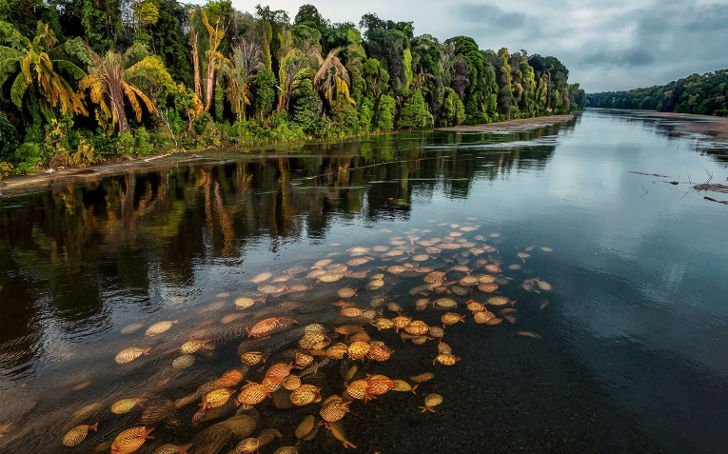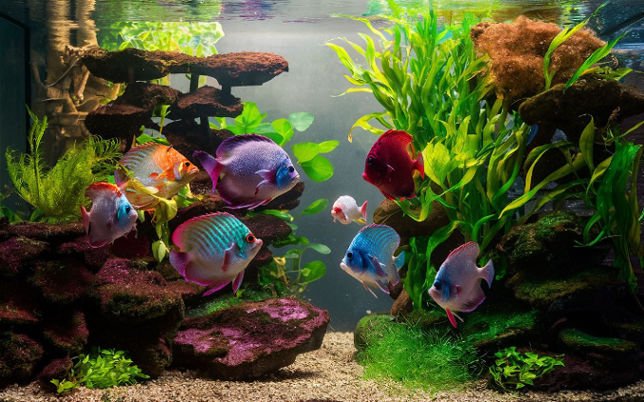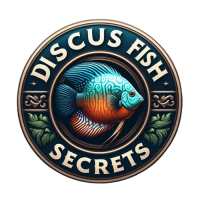Discus fish, with their distinctive saucer-like shapes and kaleidoscope of iridescent colors, are among the most captivating freshwater aquarium residents. These regal cichlids, native to the Amazon River basin, have gained immense popularity worldwide for their unique appearance and remarkably peaceful temperament.
However, caring for discus fish, while rewarding, requires specific knowledge and a dedication to providing an optimal environment. As a beginner in the hobby, venturing into the world of discus can feel daunting without the right guidance.
This comprehensive beginner’s guide aims to equip new discus enthusiasts with the foundational knowledge needed to successfully establish and maintain a thriving discus aquarium. From setting up an ideal habitat to understanding their unique dietary needs, health requirements, breeding behavior, and overcoming common challenges – this resource covers all the essential aspects of discus fish care.
Understanding Your Discus Fish
Before we dive into care and husbandry, let’s first develop an appreciation for these extraordinary fish. Discus (Symphysodon spp.) are a genus of freshwater cichlids renowned for their distinctive lateral body compression and circular shape reminiscent of a disc or plate.
In their natural habitat, the nutrient-rich rivers and flooded forests of the Amazon basin, discus fish school together near the surface, feeding on insects, larvae, and other tiny organisms. This peaceful schooling behavior translates well to home aquariums when their needs are properly met.

Discus come in a mesmerizing array of colors and patterns, with some of the most popular varieties including:
- Blue Discus
- Red Spotted Discus
- Green Discus
- Solid Colors (Blue, Brown, White)
With their calm dispositions and stunning displays, it’s no wonder discus have become such prized aquarium centerpieces.

Setting Up the Ideal Discus Environment
One of the biggest hurdles for discus beginners is understanding the specific environmental requirements of these fish. Discus are relatively sensitive to water conditions compared to many other freshwater species, so paying close attention to tank setup is crucial.
Tank Size and Selection
For a small group of 4-6 discus, most experts recommend an aquarium of at least 55-75 gallons, if not larger to accommodate for future growth. The footprint and shape also matter – discus appreciate ample surface area for swimming, so longer tanks tend to be favored over tall, narrow designs.
When selecting a tank, consider weights and dimensions carefully, as these big fish and the equipment needed to support them can get quite heavy. Many hobbyists opt for custom-built or specialty discus tanks designed specifically for their needs.
Crucial Water Parameters
Possibly the most important aspect of discus care is maintaining suitable water conditions:
- Temperature: Discus thrive in warm waters around 82-86°F. A reliable heater system is an absolute must.
- Water Chemistry: These Amazonian cichlids prefer soft, slightly acidic water with a pH around 6.0-7.0 and low mineral content (hardness). Using reverse osmosis/deionized (RO/DI) water mixed with discus-safe remineralizers is often recommended to achieve the desired parameters.
- Filtration: Discus are messy fish, so powerful filtration is key to maintaining water quality. Over-filtering with high-quality canister filters is advisable, especially for beginners.
Consistently testing water parameters and performing regular partial water changes (25-50% weekly) is crucial to keeping conditions stable for these sensitive fish.
Tank Mates for Discus
While discus fish make stunning centerpiece residents, they shouldn’t be housed alone, as they are schooling fish by nature. The good news is that their peaceful temperament allows them to be housed with a variety of tank mates, provided they have similar water needs and aren’t overly aggressive.
Some ideal discus tank mates include:
- Cory Catfish (Corydoras spp.)
- Rummynose Tetras
- Cardinal Tetras
- Pencilfish
- Otocinclus Catfish
- Apistogramma Dwarf Cichlids
Larger, territorial, or nippy fish should generally be avoided with discus. Always research any potential new additions thoroughly to ensure compatibility.

Feeding and Nutrition for Vibrant Discus
Proper nutrition plays a vital role in the health, growth, and incredible coloration of discus fish. In the wild, they feed on a varied diet of aquatic insects, worms, crustaceans, and even some plant matter.
Commercially prepared discus foods attempt to replicate this varied diet with specialized pellets, flakes, wafers, and freeze-dried products designed specifically for their nutritional needs. Many experienced keepers recommend feeding a rotating variety of these options while supplementing occasionally with small live or frozen foods like:
- Bloodworms
- Brine shrimp
- Daphnia
- Tubifex worms
Juvenile and growing discus should be fed small amounts 3-4 times per day, while adults can be fed 1-2 times per day. Take care to only provide what they can consume in 3-5 minutes to avoid overfeeding and excess waste buildup.
Maintaining Discus Health
With their large size and voracious appetites, discus produce a significant bio-load that can quickly degrade water quality. Regular tank maintenance is critical to keeping these fish healthy and stress-free.
Weekly water changes of 25-50% are recommended, along with:
- Siphoning waste from the substrate
- Cleaning filters and equipment
- Testing and adjusting water parameters as needed
- Performing partial water changes after feeding to clear excess nutrients
Signs of an issue with discus often manifest through clamped fins, loss of appetite, reclusive behavior, or visible diseases like white spot or bacterial infections. At the first hint of illness, it’s advisable to separate any affected fish to a quarantine tank for treatment.
Avoiding stressors like loud noises, sudden water changes, or aggressive tank mates is also important for preventing health issues spurred by stress in discus.
The Breeding Journey with Discus
Due to their unique breeding behaviors and challenging fry care, discus are not a beginner’s fish when it comes to breeding. However, for those willing to take on the endeavor, it can be an incredibly rewarding experience.
In nature, discus are mouth-brooders, meaning the parents take turns holding fertilized eggs and fry in their mouths for protection. This bonded pair-spawning makes choosing a compatible breeding pair key.
In a home aquarium, breeding discus require a highly mature pair, an established bonding period, pristine water conditions, and some aquascaping elements like smooth rocks or driftwood for them to lay eggs on.
Properly raising the fry is often the biggest challenge, requiring diligent care:
- Frequent small water changes
- Special fry foods and feeding schedules
- Careful handling to avoid stressing the parents into eating their young
While rewarding, discus breeding is truly an advanced-level endeavor best attempted by experienced fishkeepers.
Troubleshooting Common Discus Issues
Even with diligent care and preparation, discus keepers are bound to encounter challenges along the way. Here are some common problems to watch for:
Aggression Among Discus
While generally very peaceful fish, discus can sometimes exhibit aggression or bullying behaviors, especially among new tank additions, pairs during spawning, or if their territory or line of sight is restricted.
Quickly removing overly aggressive individuals and rearranging decor to break sight lines and territories is often enough to restore harmony. Providing ample tank space and maintaining stable parameters can also help minimize potential aggression triggers.
Water Quality Woes
Given discus’ sensitivity to water conditions, it’s not uncommon for beginners to deal with water quality issues as they work to establish and maintain the proper parameters.
Having accurate test kits, being attentive to water change schedules, double checking for potential ammonia sources, and getting expert assistance from fish stores or online communities can help pinpoint and address water quality problems.
Stunting and Growth Issues
Discus have very specific temperature and dietary needs to support their rapid growth phases when young. Insufficient heat, improper foods, aggression and stress can all contribute to a failure for young discus to achieve their full potential size.
Following expert-recommended feeding and environmental guidance is crucial, especially in those first several months, to avoid permanently stunting a discus’ growth.
Conclusion
While caring for discus fish certainly requires dedication, preparation and some trial-and-error, the breathtaking rewards make the journey well worth it for aquarium enthusiasts.
By establishing the optimal water parameters, diet, and environment, and learning to navigate common challenges, even beginners can enjoy the immense satisfaction of keeping these remarkable Amazonian beauties thriving in a home aquarium.
So take the plunge into the world of discus fish with confidence! Arm yourself with knowledge from trusted resources, be attentive to their unique needs, and most importantly – appreciate the splendor of these living works of art. The future of the discus hobby starts with you.
Share your own discus fish experiences, questions, or aspirations in the comments below. What inspires you most about these extraordinary cichlids? The ToDPDiscus community is here to support fellow enthusiasts.


